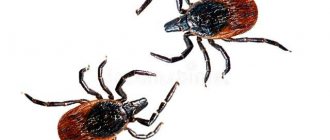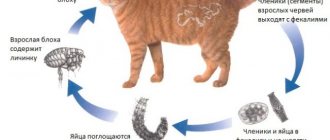Demodicosis is a parasitic pathology caused by mites of the genus Demodex, which multiply in the hair follicles and sebaceous glands of the skin. The demodex mite enters the follicle and destroys its epithelial cells. The latter become a nutrient substrate, and the hair follicle becomes a colony of parasites.
Causative agent of demodicosis
Demodex is a very small mite, only 0.5 mm long. It has an elongated transparent body with unclear boundaries between the cephalothorax and abdomen. Ticks have small legs with hooks at the ends. The oral apparatus is equipped with a proboscis.
The mite lives near the hair roots and in the sebaceous glands. There it eats dead cells and sebum and actively reproduces. Outside the animal's body, the tick dies in about 2 hours.
From egg to adult, the parasite goes through the following stages:
- larva;
- protonymph;
- deutonymph.
The tick can live in active and passive forms. In the first case, it feeds and increases in size, and in the second, it becomes motionless. The duration of the entire biological cycle is 23 days (on average). During 3 months of illness, a cat grows 3 generations of mites.
Some sources claim that Siamese and Burmese cats experience demodicosis more often than other members of the family.
Classification of the disease
The disease can occur in mild and severe forms
Demodicosis can occur in two forms, each of which has its own characteristics:
- The generalized form is characterized by extensive damage to the skin. A sick animal develops purulent rashes that give off an unpleasant odor. Generalized demodicosis affects the cat's shoulder blades, paws, neck and sides. After opening the rash, wounds remain on the skin and become crusty.
- The localized form results in a red rash that appears on the cat's face. A crust resembling scales forms on the affected areas. In attempts to clean their fur, cats often damage these formations, resulting in wounds appearing on the skin. It is through them that infection can enter the animal’s body.
What does a subcutaneous mite look like in cats: main signs
It is difficult to notice symptoms of parasitic tick activity in cats. Therefore, treatment of the disease sometimes begins untimely.
As the disease progresses, the following symptoms of demodicosis in cats occur:
- the wool becomes dull;
- redness occurs around the eyes, the skin is very flaky (outwardly it looks like dandruff);
- hair falls out in the affected area;
- tubercles and growths, cracks form on the skin;
- pustules appear that are very itchy (if the pet scratches them, they begin to bleed);
- lymph nodes enlarge.
In severe cases of the disease, the pet weakens and loses a healthy appetite.
Demodicosis can be localized or generalized. In the first case, the affected areas are not large, their number does not exceed five.
In the generalized form, the affected areas are extensive, and their number reaches six or more. Sometimes pets have skin affected throughout their body.
Diagnosis of the disease
Demodex mites can cause serious illness
When making a diagnosis, your veterinarian considers several factors. One of them is the presence of symptoms that are characteristic of demodicosis. But if you focus only on external signs, this disease can be confused with an allergic reaction, ringworm or dermatitis. To clarify the diagnosis, laboratory tests are carried out.
A skin scraping is taken from the cat. The affected area is squeezed with fingers on both sides to remove mites from the follicle, then the skin is scraped off. During the procedure, a few drops of blood may appear. Scrapings are taken at least 4-5 times, because mites can also be found on a healthy cat. Next, the collected material is sent for sowing. That is, they are placed in a special nutrient medium in which, after a certain time, colonies of microorganisms grow.
Diagnosis of demodicosis in pets
Demodicosis has similar symptoms to many other diseases (for example, lichen), so when making an independent diagnosis, the likelihood of making a mistake is very high. The help of a veterinarian in this situation is mandatory.
To detect subcutaneous mites and confirm their assumptions, a specialist will take a scraping for analysis. The biomaterial is collected at the border between healthy and disease-affected areas. It is recommended to do this in the clinic laboratory. This will increase the chances of obtaining a reliable result.
The doctor carries out scarification with a scalpel. At the same time, it necessarily captures deep layers. The biomaterial is transferred to glass, treated with a solution and examined under a microscope.
If a cat has been confirmed to have demodicosis, the owner must clean the house and wash the animal’s rug. It is important to maintain a clean environment throughout the course of therapy.
Correct treatment
Important! Do not self-treat feline demodicosis at home unless prescribed by a veterinarian. All drugs aimed at fighting the pathogen are highly toxic. Incorrect dosage and frequency of taking medications can lead to the death of the animal!
Subcutaneous mites are very difficult to treat.
To treat a localized form, it is necessary to use special shampoos containing benzoyl peroxide or chlorhexidine.
The affected areas of the skin need to be treated with peroxide and chlorhexidine solution, and then apply special anti-mite medications, available in the form of ointments, gels or liniments.
If we talk in more detail about drugs and remedies against demodex, these are acaricidal drugs.
In some cases, it is recommended to apply special oil solutions. In parallel with external agents, it is recommended to include immunostimulants for cats in therapy.
In the case of a localized form of the disease, remission may occur after a month, the symptoms of inflammation disappear. But don’t rush to flatter yourself. This does not mean that the animal is healthy. It’s just that the disease is in dormant mode, so that under favorable conditions it can become more active, but in a more severe form.
Therefore, the effectiveness of early treatment is higher than the treatment of advanced demodicosis.
The nature of treatment is influenced by the cat’s age and breed; in order to achieve stable remission, a long course of therapy is required, which lasts up to 12 months.
Treatment of the generalized form begins with eliminating the disease that provoked the outbreak of the disease, combining this course with the course of treatment for the localized form of the disease. It is mandatory to take vitamins and immunostimulants . In particularly severe cases, a course of antibiotics is also prescribed.
The veterinarian who cares for the cat should prescribe veterinary medications. If necessary, he will adjust the treatment regimen, including new drugs and excluding those that are ineffective for your case.
After starting treatment, all cat accessories should be replaced with new ones or disinfected to eliminate the possibility of re-infection. This applies to cat bowls, cat houses, scratching posts, combs for combing fur, and toys. If it is not possible to disinfect them, it is better to part with them.
Treatment with folk remedies
There are also folk remedies for treating demodicosis at home; before using these methods, it is recommended to consult a veterinarian so as not to harm your pet’s health even more.
This alternative treatment involves:
- Bathing the cat in chamomile decoction every 2-3 days
- Treatment of infected areas with kerosene (do not rinse or treat the skin for 2 days after this procedure)
- Treatment of affected skin areas with calendula tincture
- Washing the cat's skin with soap or gel containing birch tar.
You should not rely on these at-home methods alone. But, as an auxiliary therapy, if the veterinarian does not prohibit it, it can be used.
Prevention
By supporting the animal's immunity with vitamin complexes (purchased at a veterinary pharmacy), timely vaccination, and systematic flea treatment, you reduce the risk of infection with demodicosis. If one animal is suspected of having ticks, it must be immediately isolated from the rest so that it does not infect other cats.
A timely visit to a veterinarian if you suspect a subcutaneous tick and strict adherence to his recommendations allows you to obtain a favorable prognosis for your cat.
Leave your questions in the comments
How to treat subcutaneous mites in a cat
Demodicosis in cats can be treated only according to the recommendations given by a veterinarian. Typically, therapy includes measures aimed at eliminating the pathogen and increasing the cat’s immunity. This approach to the problem will ensure a quick recovery and help prevent relapse.
Localized form
Treatment for subcutaneous mites in a cat begins with bathing it. Shampoos “Elite” or “Doctor” are suitable for this. They help remove dead skin cells and excess sebum and normalize sebum secretion. The antibacterial properties of these products promote the healing of existing rashes and prevent the appearance of new ones.
After bathing the animal, when its fur is dry, the diseased areas are treated with Chlorhexidine or hydrogen peroxide.
Further therapy is carried out using potent drugs. They cause paralysis and death of parasites. The medication is used not only at the location of the tick itself, but also on healthy skin near pathological foci. Lubricate according to the instructions, usually 1-2 times a week until the animal recovers.
This treatment is not recommended for pregnant or lactating cats. Acaricidal agents are used with extreme caution to treat animals that have infectious diseases.
To kill ticks, doctors often prescribe:
- Mycodemocid;
- Perol;
- Ivermek.
Throughout the course of treatment, the cat must be given vitamins (for example, Gamavit or Maxidin). This will speed up skin regeneration, improve coat quality, and strengthen the immune system.
For mild cases of demodicosis, traditional methods are used. Tar soap or shampoo, sulfur ointment, as well as a decoction of calendula, sage and chamomile are perfect for this.
It is strictly not recommended to scratch the rash and tear off scabs on the animal’s body. This will lead to aggravation of the existing problem and bacterial infection entering the wounds.
Generalized form
Before starting treatment for demodicosis in a cat, it is shaved. This will allow you to treat the affected skin efficiently.
In the generalized form, just as in the previous case, the cat is bathed with Elite shampoo and then treated with Chlorhexidine.
After this, the medicine for subcutaneous mites in cats, Cydectin, is injected. Its dosage is 0.5 ml per 1 kg of animal weight. After a one-week interval, the injection is repeated.
It is also recommended to use one of the following antibiotics in addition:
- Amoxicillin;
- Baytril;
- Amikacin.
The use of vitamin and immunostimulating drugs for generalized demodicosis is mandatory. Among these, Ligfol, Immunal, and Immunoparasitan give good results.
To enhance the effect of therapy, Amit Forte drops are used on the withers.
Symptoms
Clinical signs of pathology in cats appear gradually, and the sooner you seek help from a doctor, the higher the chances of your pet’s recovery.
- skin redness;
- the appearance of rashes in the form of nodules or small pustules;
- deterioration in the appearance of fur;
- such a characteristic symptom appears as “demodicosis glasses” - hair loss and peeling of the skin around the eyes;
- hair loss and peeling of the skin on the head, ears, neck (localized form), as well as on the legs and torso (generalized form);
- skin pigmentation disorder;
- acne;
- itching;
- bleeding wounds.
In the generalized form, damage to the internal organs is noted, which affects the general condition of the animal - weakness, apathy, decreased appetite, etc.
Diagnostics
To identify subcutaneous mites, scrapings are taken from the affected areas of the cat’s body (at least 4-5 samples) for further examination under a microscope.
The detection of at least one Demodex gatoi mite in a scraping gives the veterinarian the right to diagnose demodicosis. In the case of the subcutaneous mite Demodex cati, the situation is different. This mite lives on every cat. The diagnosis is made if more than 2-3 individuals are found in one scraping.
Additional research:
- biopsy;
- trichogram (hair examination).
How dangerous is demodicosis for a pet?
If parasitic mites are not dealt with, they will make your cat’s life unbearable. Parasites will constantly provoke pain and itching in the animal, literally eating its skin.
In this case, the disease will further undermine the pet’s immunity. As a result, he will become more vulnerable to many infections and diseases. Sometimes demodicosis in cats causes death.
The medications used to eliminate ticks are extremely toxic to cats. To neutralize their negative impact on the liver, the animal is given hepatoprotectors (for example, Hepatovet or Essentiale).
Causes of red scabies
Subcutaneous mites in cats occur in all breeds. There are no restrictions by gender or age. However, it has been noted that Siamese and Burmese breeds are more often affected.
At risk:
- Animals with weakened immunity due to genetic diseases, previous infections, infection with worms, fleas, and those who have been treated with antibiotics for a long time.
- Pets up to 1-2 years old and over 5 years old.
- Kittens are artificial or taken from their mother early.
- Cats with skin diseases, wounds, abrasions.
No less influence on the immune system is exerted by nutrition, living conditions, and exposure to stress.
Prevention of demodicosis in cats
The skin mite is a conditionally dangerous parasite. Usually they are present on the animal’s body, but in minimal quantities. Normally, they cleanse the skin of dead particles. However, when the body's defenses decrease, the number of ticks increases sharply, and then the disease develops.
Thus, prevention should include strengthening the animal’s own defenses. Cat owners must feed it properly and provide adequate living conditions. For animals that are predisposed to the disease, it is useful to administer Immunoparasitan once every six months.
Periodically, the cat needs to be treated with flea medications and given anti-worm medication. During walks, it is important to ensure that the cat does not come into contact with stray animals.
Even if the symptoms of the disease have disappeared, treatment should not be stopped prematurely. To confirm recovery, an additional examination of the scraping is carried out.
Features of caring for a sick animal
Care consists of timely response and treatment of the disease. The affected areas should be regularly lubricated with the medicine and the formation of new lesions should be prevented. In order for the cat’s immune system to cope with the disease faster, the pet must be provided with adequate nutrition. During this period, the animal’s body needs proteins. If you feed your cat natural food, introduce more meat, fish and dairy products into the diet.
When using special mixtures, choose premium formulations. These foods are made from natural ingredients and will provide your cat with the necessary nutrients. These include brands such as Eukanuba, Hills, Purina, Lams, Pro Plan, Royal Canin, Acana. When feeding naturally, give your cat general strengthening vitamin complexes: Exel BREWERS YEAST, VITA-BON cat, Nutri-Vet.
Important! At the first signs of demodicosis, contact your veterinarian immediately.
Questions and answers on the disease
Can a sick person infect others?
Yes, you can become infected with demodicosis through contact and household contact. Kissing, hugging, contact with contaminated things of a patient (towel, bed linen, clothes and much more) can be dangerous for a healthy person. But this does not guarantee the manifestation of symptoms of the disease. Ticks of the genus Demodex are representatives of the opportunistic microflora of the skin. They are found in almost all people, but most of them are simply carriers. For the development of a pathological process, the presence of certain factors is necessary (for example, reduced immune defense against the background of an active or past disease).
Can you get infected from animals?
Animals, like humans, suffer from the activity of Demodex mites. But pathogens come in different types - and each of them survives exclusively in the body of its host. When exposed to other conditions, the parasite immediately dies. Therefore, it is impossible to become infected with demodicosis from a pet or wild animal.











